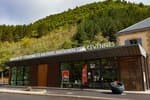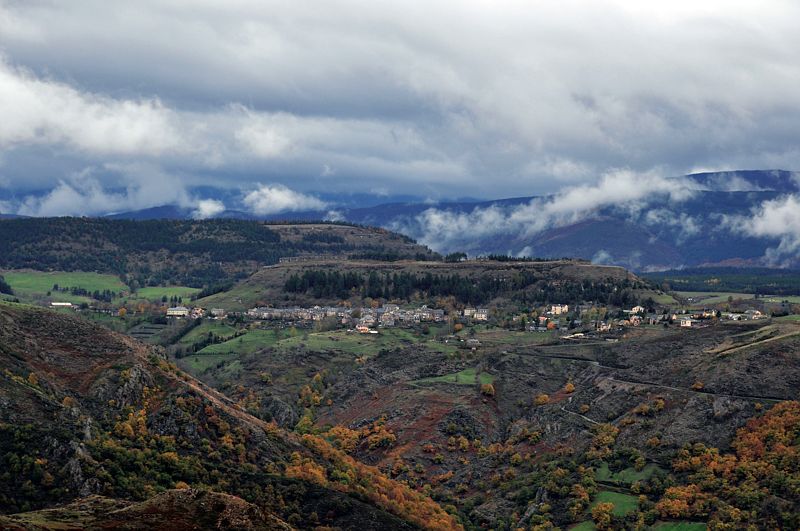
Barre-des-Cévennes
In the shelter of the Castelas, the facades of Barre-des-Cévennes line up, reminding us of its past as a rich and lively small town. In fact, the village is located at the very hinge of two different but complementary regions, and controls one of the most frequent crossing points between the Lower and Upper Cévennes. The trail leads you from gardens to fountains, from the temple (Protestant church) to the Catholic church, to the old fairgrounds and then onto the heights, where you can enjoy exceptional panoramic views onto the scenery of the Cévennes National Park.
22 points of interest

 History
HistoryPlace de la loue (Hiring Square)
Marker 1
This little square, located at the north-eastern entrance to the village, was where the “loue” (hiring) used to be held during the great spring and autumn fairs: shepherds, domestics and chestnut gatherers would sit on the parapet and hope for an employer to take them on. The village hosted 12 to 15 fairs every year. The spring and autumn ones could attract up to ten thousand people from neighbouring departments, but also from the Var, Vaucluse and Bouches-du-Rhône. This village-rue (one-road village) was protected at each end by a fortified gate. One of them, called the Florac Gate, stood near the Place de la Loue. It was destroyed in the early 19th century.
 Geology
GeologyBedrocks and construction
Marker 3
Different types of rock were used to build the village, as in the courtyard on your left, in particular limestone (5) and quartzite (2) for houses. Additionally, sandstone (4) and granite (1) were used for retaining walls, and mica schist for roofs (3). These rocks came from the immediate surroundings of Barre, where they make up the landscape’s structure. This can be seen in the foreground, looking south-west. On each side of the narrow street are the terraced gardens. This system, typical of mountain regions, makes it possible to retain soil by reducing gradients. Oral tradition has it that local lords granted their feudal tenants these gardens free of charge.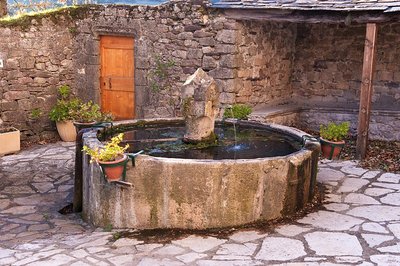
Fontaine du Thérond - © Guy Grégoire  Architecture
ArchitectureThéron Fountain
Marker 2
Barre was built on the contact zone between sandstone and mica schist. Several springs and seeps emerge from this impermeable zone, which feed into the village’s fountains and garden wells. The oldest, the Théron Fountain, has been restored several times. The typical Barre house is generally taller than it is wide, probably to avoid encroaching on cultivatable land. On the ground floor would have been a shop, workshop, storage space, or the stable; on the first floor, the kitchen; and above that one or two bedrooms. At the very top, a hay loft would have been used to store hay and straw.
 Flora
FloraWall plants
Marker 3
Vegetation on walls has to overcome the lack of both soil and water. To persist under these conditions, there are three possible strategies:
- spending the hardest season as seeds, as annuals do, e.g. thyme-leaved sandwort (arenaria serpyllifolia);
- laying in water reserves, as succulent plants do, e.g. white stonecrop (sedum album);
- drying out without dying, as lichens and mosses do. By breaking down the substrate, these also create a bit of soil for superior plants (those with flowers and therefore seeds: sandwort, stonecrop, etc.).
 History
HistoryPlace des écoles (Schools Square)
Marker 4
“Schools Square” has changed name several times over the years. In the Middle Ages, it was known as PourcariéSqaure because it hosted the pig market. Later the market also opened up to oxen, horses and mules, and was therefore renamed the Fairground Square. It was the most important area of the fairs, where the largest sums of money changed hands. During the Protestant Camisard Rebellion (1702-1704), the square was protected by a large wooden palisade. During the 1789 French Revolution, the National Guard held arms drills here, and its name changed to Arms.
 History
HistoryPlace de la Madeleine
Marker 5
The fountain dates from the 18th century. At the end of the 19th century, the bust of Marianne – the personification of the French Republic – was added. At the same time, a poplar was planted by republican youth as a symbol of freedom. From here, you can see several bourgeois houses, which mostly date from the 17th and 18th centuries. They bear witness to the village’s thriving past, when it had some 20 voituriers (merchant-carters), who would drive their carts down to the plains laden with wool and chestnuts and return with salt, wine and oil. Under the houses' large porches, harnesses and carts were kept. During fairs, the seed market took place in these vaults and those of the town hall.
 History
HistoryThe Château
Marker 6
Constructed in the 12th and 13th centuries, the Château was entirely rebuilt in the early 16th century. From 1710 to 1715, it was modified by the Lord of Barre, who had his coat of arms carved above the entrance. Two towers were also added at this time. During the 1789 Revolution, the coat of arms disappeared under vigorous hammer strokes. In the early 19th century, during an expansion, the main tower was removed.
 History
HistoryThe temple (Protestant church)
Marker 7
Begun in 1823 and finished in 1826, this temple was Barre’s third. Its architecture is similar to that of all the temples built at this time. The first temple had been constructed in 1608 near the Catholic church, shortly after the arrival of Protestantism in the region. Only one of its stones still exists and can today be seen in the facade of a house on the main street, inscribed: “He who is of God hears the word of God – 1608”. In 1675 Protestants built a second temple below the village. It was destroyed on Royal orders in 1685 following the Revocation of the Edict of Nantes (which re-criminalised Protestantism), forcing Protestants to hold their religious gatherings in the mountains.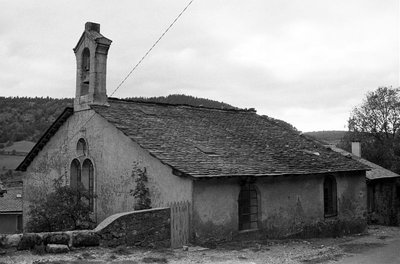
Église de Barre-des-Cévennes - © Guy Grégoire  Architecture
ArchitectureThe Catholic church
Marker 8
The church was probably built in the 12th century. Its barrel-vaulted nave is Romanesque in style. The original building was extended by several lateral additions in the Gothic style: in the 14th century, a chapel (north side) featuring the coat of arms of the Lords of Barre; in the 15th, three chapels on the south side. The church has been a listed building since 1931. In front of it is the Place de la Bladarié, which hosted the medieval seed market and, as of the 16th century, the sheep market.
 History
HistoryPlace de l'Orient
Marker 9
Barre’s third fountain used to stand on this square, where the pig market was held from the 16th century onwards. At the entrance to the main road was the Cévennes Gate, dismantled in 1836 because it obstructed carts. The houses adjoining this Gate and the Florac Gate were requisitioned during the Camisard War to house the King’s soldiers. At the time, Barre was one of their main garrisons.
 Natural environment
Natural environmentAsh trees pruned in the “tadpole” style
Marker 10
No water runs in this little gully in the summer. You can see a large number of ash trees of a particular shape caused by regular pruning, called “tadpole”. Ash trees prefer relatively deep and humid soils, but locals have privileged it here over its direct rivals (willows, aspen, and hazelnuts). Celts and Germanic tribes already considered the ash a sacred tree, believing it to attract lightning and beneficial rains. Its hard and elastic wood is much appreciated in cabinet-making. It is also used for tool handles. The first skis were made of ash. Farmers use ash leaves as supplementary fodder for livestock.
 Geology
GeologyCan Noire
Marker 11
In front of you is an abrupt slope broken halfway by a level shelf. This shelf corresponds to a strip of the peneplains which, at the end of the Palaeozoic (between 280 and 230 million years ago) resulted from the complete erosion of the great Hercynian mountain chain. Below the shelf are rocks established between 350 and 280 million years ago: essentially mica schist (3) and granite (1). Here, the steep slopes with their thin acid soils are covered by Cévenol heaths of broom, heather, bracken and thyme. A few sessile (durmast) oaks, ash and willows break up the monotony. Above the shelf are sandstone (4), dolomite rock (6) and limestone (5), deposited by the sea in the Mesozoic, between 230 and 190 million years ago.
 History
HistoryVillage de vacances (holiday village)
Marker 12
Barre’s holiday village was built in 1971 by the association of local councils. It consists of 30 units and can accommodate 180 people. The impetus behind its construction was a re-orientation of Barre’s economy towards tourism.
 Geology
GeologySandstone outcrop
Marker 13
On the other side of the road, the sandstone bank shows criss-crossing layers which were deposited by flood waters with very strong currents. The pebbles they contain have angles that are barely blunted, indicating that they were not carried far. This very crumbly sandstone is generally held together by a greenish clay rich in white mica without any limestone. It bears witness to the arrival of the sea, 200 million years ago. On this rock face, plants have to compensate for intense erosion by being able to develop rapidly and withstand a certain amount of dryness. There are a very few chamomile plants and streamlined plantains.
 Geology
GeologyEroded sandstone
Marker 14
Some 10 metres below the path, there are areas of denuded, strongly eroded sandstone. These areas suffer from substantial loss of materials, especially during the strong autumn and spring rains. Plants cannot get established here. Only trees, if they were to grow, could stop the process. Their large root system would hold back the soil while their branches would protect it from the worst of the rains. The sandstone is topped by dolomite rock, limestone and marl containing marine fossils: mussels, pectens (saltwater clams), etc.
 Natural environment
Natural environmentForest
Marker 15
The landscape stretching eastwards is characterised by forest. Over 60% of the surface area is covered in woods, of which 40% are conifers. Many of the latter are species introduced by the Office National des Forêts (the body that manages state forests): European Black Pines and Nordmann Firs on the heights, Douglas Firs in the depressions. Scots Pines – an indigenous species which colonised former sheep pastures after they were abandoned at the end of the 19th century – are usually relegated to poor and thin soils. Only 20% of the wooded area is taken up by deciduous trees, essentially beeches, sessile oaks and birches.
Barre-des-Cévennes - © Pierre Lahoud  History
HistoryRuiniform rocks
Marker 16
The Castelas, a butte, is a vestige of the area’s former limestone top layer. It has been cut off from the great Causses by erosion. It was settled in about 2500 BC by tribes from the scrublands of Languedoc. On the three rocks left by erosion are ten or so rectangular holes. They are believed to have supported the base of a wooden signal tower.
 Flora
FloraRock plants
Marker 17
These rocks offer a plant habitat comparable to stone walls, but plants have been established here for longer. Most shelter along fissures or shelves, where they can find a few minerals and organic matter, leaving the smooth rock faces to lichens. The dolomite rock has created particular soil conditions here, which are favourable to certain plants such as Kernera saxatilis. Erosion has created small cavities that shelter certain birds, such as the black redstart (phoenicurus ochruros) in summer and the alpine accentor (prunella collaris) in winter.
 Water
WaterThe watershed
Marker 18
At the centre of the landscape, the river Malzac meanders through the relatively gentle relief and then flows into the Mimente in the Atlantic catchment area. Meanwhile the Grisoulle, on your left, is a tributary of the Gardon, which flows into the nearby Mediterranean, cutting abrupt slopes into the relief as it goes. The Grisoulle’s gradient is six times steeper than the Malzac’s. It is quite possible that in a few thousand years, the Grisoulle will capture the Malzac and profoundly alter the landscape. The little pass that separates them is the watershed, which also goes through the Castelas and Can Noire.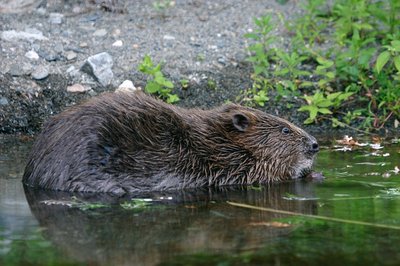
Castor au réfectoire - © Bruno Descaves AgricultureThe Malzac valley
The erosion caused by the Malzac, weaker than that caused by the Griboulle, has left more land usable for crops and fields. This allows farmers to keep a few cow herds. The region’s climate, relief and soils force its inhabitants to base the local economy on agricultural and forestry activities of low productivity. At the same time, climatic and environmental variety generates a large range of plant and animal species, the source of abundant bio-diversity. The Cévennes National Park has worked hard to conserve this wealth by re-introducing some species that had disappeared: roe deer, stags, the Western capercaillie, beavers, and the griffon vulture.

 Natural environment
Natural environmentScree
Marker 19
Limestone is made up of thin layers topped by thicker ones. Water penetrates into the rock’s interstices and, when it freezes, fractures it. The base layers are more fissured and therefore eliminated more quickly. That is how the overhangs you can see at three different heights were created. These rocky environments have an important ecological role because they are a refuge for certain species of plants (French-leaf sorrel) and animals (little owl). A little further down, some seeps support wetland vegetation: horsetails, hemp-agrimony. This is also a meeting-point for many butterflies (great banded grayling, marbled white), which are the only creatures that can reach the nectar deep inside hemp-agrimonies and plume thistles.
 History
HistoryPlace des Ayres (Threshing Square)
Marker 20
So called because it used to be where most of Barre’s farmers came to thresh their grains using flails. This technique, known since Gallo-Roman times, was for a long time the most widely used.
Description
A few clarifications:
• A few dozen metres after Point 6, take the stairs on the right.
• Between Points 9 and 10, the path may be closed by two barriers. Please be sure to close them again after yourself.
• Steep uphill section after Point 13.
• At Point 16, do not climb the rocks – risk of falling.
• Steep downhill section after Point 18.
- Departure : Public weigh-station (poids public) as you enter Barre-des-Cévennes
- Arrival : Place des Ayres
- Towns crossed : Barre-des-Cévennes
Forecast
Altimetric profile
Recommandations
This trail has rather steep slopes (60%) and cliff sections that are difficult for people with walking difficulties. Children must be kept under parents' supervision. Horse-riding or mountain-biking are not allowed on or adapted to discovery trails.
Information desks
Tourism'house and national Parc at Florac
Place de l'ancienne gare, N106, 48400 Florac-trois-rivières
This office is part of the National Park's associated tourist-information network, whose mission is to provide information on, and raise awareness of, the sites and events as well as the rules that must be observed in the National Park's central zone.
On site: exhibitions, video projections, events and shop Open year-round
Access and parking
Barre-des-Cévennes on the D 907 and then D 9 from Florac; after Nozières hamlet, take the D 983 on the left.
Parking :
Calculateur d'itinéraire Lio
Utilisez le calculateur liO pour organiser votre trajet en région Occitanie.
Autres régions
Calculez votre itinéraire en Auvergne Rhône Alpes sur Oùra
Biodiversité autour de l'itinéraire
Source

Report a problem or an error
If you have found an error on this page or if you have noticed any problems during your hike, please report them to us here:

